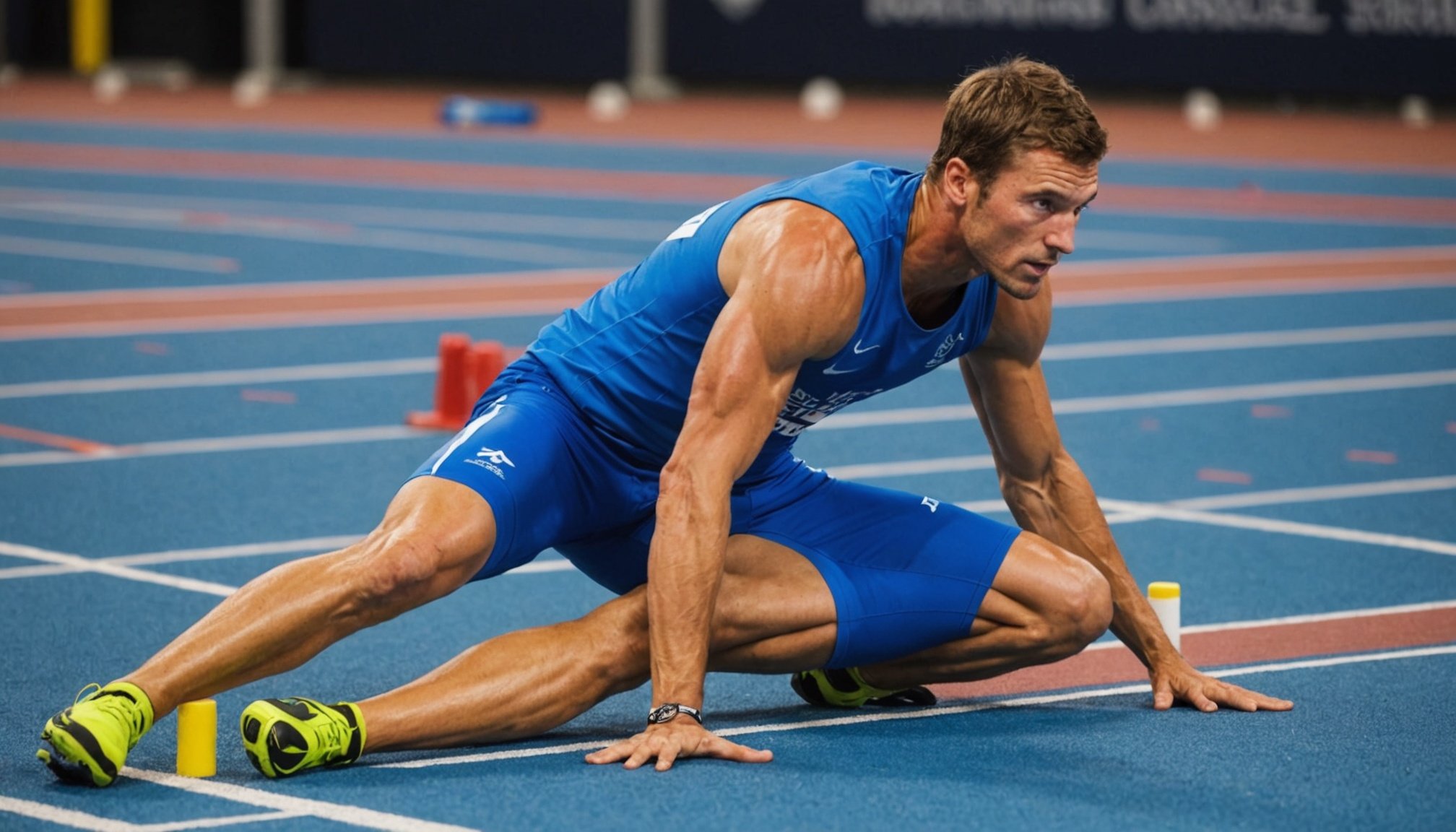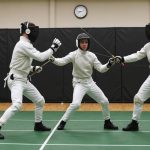Unlocking the Secrets to Post-Pentathlon Recovery: Essential Strategies for Effective Cool Down
When athletes compete in demanding events like the pentathlon, recovery is just as crucial as the training itself. The pentathlon, a multi-discipline sport that includes fencing, swimming, equestrian show jumping, and a combined run and shoot event, pushes athletes to their limits. Here, we will delve into the essential strategies for effective cool down and recovery, ensuring that athletes can bounce back stronger and more resilient than ever.
Understanding the Importance of Recovery
Recovery is not just a passive process; it is an active and integral part of any athlete’s training regimen. After a grueling event like the pentathlon, the human body needs time to repair and rebuild muscle tissue, replenish energy stores, and restore mental clarity.
Additional reading : Essential hydration tips for outdoor track events: your complete guide to avoiding dehydration
“Recovery is where the magic happens,” says Dan John, a renowned strength coach. “It’s not just about resting; it’s about actively helping your body recover so you can come back stronger and perform at a higher level”[1].
Immediate Post-Event Cool Down
The immediate cool down period following an event is critical. Here are some strategies athletes can use to kickstart their recovery:
In parallel : Essential strength training exercises every elite rock climber must perfect
Gradual Reduction in Intensity
After the intense effort of a pentathlon, it’s essential to gradually reduce the intensity of physical activity. This can involve light jogging, cycling, or swimming to help the body transition from a high-intensity state to a more relaxed one.
Static Stretching
Static stretching can help improve flexibility and reduce muscle soreness. Focus on the major muscle groups used during the event, such as the legs, back, and shoulders.
Foam Rolling and Self-Myofascial Release
Using a foam roller or other tools for self-myofascial release can help alleviate muscle tension and improve blood flow. This is particularly beneficial for areas that are prone to tightness, such as the IT band and quadriceps.
Detailed Cool Down Routine
Here is a detailed cool down routine that athletes can follow:
- Light Cardio (10-15 minutes)
- Engage in light cardio activities like jogging, cycling, or rowing to help your body transition from a high-intensity state.
- Static Stretching (15-20 minutes)
- Focus on major muscle groups:
- Hamstrings
- Quadriceps
- Calves
- Back
- Shoulders
- Hold each stretch for 20-30 seconds and repeat 2-3 times.
- Foam Rolling and Self-Myofascial Release (10-15 minutes)
- Target areas like the IT band, quadriceps, and lower back.
- Spend 30-60 seconds on each area, applying moderate pressure.
Nutrition and Hydration for Recovery
Proper nutrition and hydration are vital components of the recovery process. Here’s what athletes should focus on:
Sports Nutrition
- Carbohydrates and Proteins: Consuming a mix of carbohydrates and proteins within 30-60 minutes after the event can help replenish energy stores and support muscle repair. Aim for a ratio of 3:1 or 4:1 carbohydrates to proteins.
- Hydration: Adequate hydration is crucial. Aim to drink at least 16-20 ounces of fluid for every pound of body weight lost during the event.
- Electrolytes: Include electrolyte-rich foods or supplements to help rebalance what was lost through sweat.
| Nutrient | Why It’s Important | Examples |
|---|---|---|
| Carbohydrates | Replenish energy stores | Bananas, whole grain bread, sports drinks |
| Proteins | Support muscle repair | Lean meats, fish, eggs, protein shakes |
| Electrolytes | Rebalance lost electrolytes | Coconut water, sports drinks, bananas |
| Water | Hydrate the body | Plain water, herbal teas |
Mental Recovery Strategies
Mental recovery is just as important as physical recovery. Here are some strategies athletes can use:
Competition Simulation and Mental Practice
- Practice visualization techniques to relive successful performances and prepare for future events.
- Use competition simulation to mentally rehearse the event, focusing on positive outcomes and managing stress[2].
Emotion Control and Behavioral Routines
- Develop routines that help manage emotions, such as deep breathing exercises or positive self-talk.
- Establish consistent behavioral routines that provide a sense of comfort and control.
Relaxation Techniques
- Use relaxation techniques like progressive muscle relaxation, mindfulness meditation, or yoga to reduce stress and promote relaxation.
- “Relaxation could serve as a regeneration accelerator and is particularly helpful in case athletes tend to be nervous prior to competition,” notes a study on sport psychological interventions[3].
Long-Term Recovery and Strength Conditioning
Long-term recovery involves ongoing strength conditioning and training strategies that support overall performance and resilience.
Periodization
- Implement periodized training plans that include phases of high-intensity training followed by periods of recovery and lower intensity.
- This helps avoid burnout and ensures the body has time to adapt and recover.
Strength Training
- Incorporate strength training into your regimen to build resilience and improve overall performance.
- Focus on exercises that enhance functional strength, such as squats, deadlifts, and bench presses.
High Performance Training
- Engage in high-performance training programs that include explosive strength training, plyometrics, and speed training.
- These types of training can be found in podcasts like “Raise the Bar with Troy Haines,” which features experts discussing cutting-edge training techniques[1].
Social Media and Community Support
In today’s world, social media can be a powerful tool for athletes seeking support and motivation.
Follow Inspirational Accounts
- Follow accounts of world-class athletes, coaches, and sports scientists to stay updated on the latest training methods and recovery strategies.
- Accounts like @kylek.fit and @skyhiandflyjumplab offer valuable insights and inspiration[1].
Join Online Communities
- Join online forums and groups where athletes share their experiences, tips, and advice on recovery and training.
- These communities can provide a sense of belonging and support, which is crucial for mental recovery.
Practical Advice for Young Athletes
For young athletes just starting their journey, here are some practical tips:
Listen to Your Body
- Pay attention to your body and take rest days when needed. Overtraining can lead to injuries and burnout.
- “The key is to listen to your body and not push yourself too hard,” advises a seasoned coach.
Seek Professional Guidance
- Work with a coach or trainer who can tailor a training and recovery plan to your specific needs.
- “Having a good coach is like having a guide who helps you navigate the world of sports,” says Fabian Delryd, a guest on “Raise the Bar with Troy Haines”[1].
Enjoy the Journey
- Remember to enjoy the process of training and competing. Sports are a journey, not just a destination.
- “Enjoy the episode, enjoy the journey, and let the process be your reward,” is a common theme in many podcast episodes focused on athletic development[1].
Recovery is an art and a science that requires careful planning and execution. By incorporating these strategies into your post-pentathlon recovery routine, you can ensure that you are not only recovering effectively but also setting yourself up for future success.
Whether you are a seasoned athlete or a young athlete just starting out, understanding the importance of cool down, nutrition, mental recovery, and long-term strength conditioning is crucial. Remember, recovery is where the real magic happens, and with the right strategies, you can unlock your full potential and achieve world-class performance.











